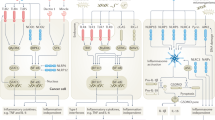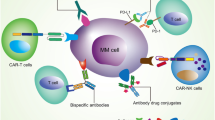Abstract
Multiple myeloma (MM) patients are strongly vulnerable to infections, which remain a major cause of death. During infection, human immune cells sense the presence of invading pathogens through the Toll-like receptor family (TLR), which recognizes pathogen-associated molecular patterns (PAMP). We hypothesized that MM cells also could sense the presence of microorganisms, thus promoting myeloma disease progression. Here, we report that human myeloma cell lines (HMCL) and primary myeloma cells express a broad range of TLR, and are sensitive to the corresponding PAMP. Toll-like receptor 1, 7 and 9 are most frequently expressed by HMCL. The expression pattern of TLR does not correlate with the one of B cells, as TLR2 and 10 are lost while TLR3, 4 and 8 are acquired by some HMCL. Culture with TLR7- and TLR9-ligands saves HMCL from serum-deprivation or dexamethasone-induced apoptosis. Similarly, both ligands increase myeloma cell growth. These effects are mediated by an autocrine secretion of interleukin-6 (IL-6) since the neutralization of IL-6 blocks the growth and survival of HMCL. Thus, TLR expression and function are not restricted to the cells of the immune system and could be of advantage for cancer cells. In MM, recurrent infections could promote tumor growth and favor escape from standard therapies.
This is a preview of subscription content, access via your institution
Access options
Subscribe to this journal
Receive 12 print issues and online access
$259.00 per year
only $21.58 per issue
Buy this article
- Purchase on Springer Link
- Instant access to full article PDF
Prices may be subject to local taxes which are calculated during checkout




Similar content being viewed by others
References
Bataille R, Harousseau JL . Multiple myeloma. N Engl J Med 1997; 336: 1657–1664.
Blade J, Kyle RA, Greipp PR . Presenting features and prognosis in 72 patients with multiple myeloma who were younger than 40. Br J Haematol 1996; 93: 345–351.
Iwasaki A, Medzhitov R . Toll-like receptor control of the adaptive immune responses. Nat Immunol 2004; 5: 987–995.
Pulendran B . Modulating vaccine responses with dendritic cells and Toll-like receptors. Immunol Rev 2004; 199: 227–250.
Manukyan M, Triantafilou K, Triantafilou M, Mackie A, Nilsen N, Espevik T et al. Binding of lipopeptide to CD14 induces physical proximity of CD14, TLR2 and TLR1. Eur J Immunol 2005; 35: 911–921.
Alexopoulou L, Holt AC, Medzhitov R, Flavell RA . Recognition of double-stranded RNA and activation of NF-kappaB by Toll-like receptor 3. Nature 2001; 413: 732–738.
Poltorak A, He X, Smirnova I, Liu MY, Van Huffel C, Du X et al. Defective LPS signaling in C3H/HeJ and C57BL/10ScCr mice: mutations in Tlr4 gene. Science 1998; 282: 2085–2088.
Hayashi F, Smith KD, Ozinsky A, Hawn TR, Yi EC, Goodlett DR et al. The innate immune response to bacterial flagellin is mediated by Toll-like receptor 5. Nature 2001; 410: 1099–1103.
Heil F, Hemmi H, Hochrein H, Ampenberger F, Kirschning C, Akira S et al. Species-specific recognition of single-stranded RNA via toll-like receptor 7 and 8. Science 2004; 303: 1526–1529.
Diebold SS, Kaisho T, Hemmi H, Akira S, Reis e Sousa C . Innate antiviral responses by means of TLR7-mediated recognition of single-stranded RNA. Science 2004; 303: 1529–1531.
Hemmi H, Takeuchi O, Kawai T, Kaisho T, Sato S, Sanjo H et al. A Toll-like receptor recognizes bacterial DNA. Nature 2000; 408: 740–745.
Kadowaki N, Ho S, Antonenko S, Malefyt RW, Kastelein RA, Bazan F et al. Subsets of human dendritic cell precursors express different toll-like receptors and respond to different microbial antigens. J Exp Med 2001; 194: 863–869.
Jarrossay D, Napolitani G, Colonna M, Sallusto F, Lanzavecchia A . Specialization and complementarity in microbial molecule recognition by human myeloid and plasmacytoid dendritic cells. Eur J Immunol 2001; 31: 3388–3393.
Lore K, Betts MR, Brenchley JM, Kuruppu J, Khojasteh S, Perfetto S et al. Toll-like receptor ligands modulate dendritic cells to augment cytomegalovirus and HIV-1-specific T cell responses. J Immunol 2003; 171: 4320–4328.
Kamath AT, Sheasby CE, Tough DF . Dendritic cells and NK cells stimulate bystander T cell activation in response to TLR agonists through secretion of IFN-alpha beta and IFN-gamma. J Immunol 2005; 174: 767–776.
Hornung V, Rothenfusser S, Britsch S, Krug A, Jahrsdorfer B, Giese T et al. Quantitative expression of toll-like receptor 1–10 mRNA in cellular subsets of human peripheral blood mononuclear cells and sensitivity to CpG oligodeoxynucleotides. J Immunol 2002; 168: 4531–4537.
Bourke E, Bosisio D, Golay J, Polentarutti N, Mantovani A . The toll-like receptor repertoire of human B lymphocytes: inducible and selective expression of TLR9 and TLR10 in normal and transformed cells. Blood 2003; 102: 956–963.
Poeck H, Wagner M, Battiany J, Rothenfusser S, Wellisch D, Hornung V et al. Plasmacytoid dendritic cells, antigen, and CpG-C license human B cells for plasma cell differentiation and immunoglobulin production in the absence of T-cell help. Blood 2004; 103: 3058–3064.
Jego G, Palucka AK, Blanck JP, Chalouni C, Pascual V, Banchereau J . Plasmacytoid dendritic cells induce plasma cell differentiation through type I interferon and interleukin 6. Immunity 2003; 19: 225–234.
Bernasconi NL, Onai N, Lanzavecchia A . A role for Toll-like receptors in acquired immunity: up-regulation of TLR9 by BCR triggering in naive B cells and constitutive expression in memory B cells. Blood 2003; 101: 4500–4504.
Jego G, Robillard N, Puthier D, Amiot M, Accard F, Pineau D et al. Reactive plasmacytoses are expansions of plasmablasts retaining the capacity to differentiate into plasma cells. Blood 1999; 94: 701–712.
Heil F, Ahmad-Nejad P, Hemmi H, Hochrein H, Ampenberger F, Gellert T et al. The Toll-like receptor 7 (TLR7)-specific stimulus loxoribine uncovers a strong relationship within the TLR7, 8 and 9 subfamily. Eur J Immunol 2003; 33: 2987–2997.
Hartmann G, Krieg AM . Mechanism and function of a newly identified CpG DNA motif in human primary B cells. J Immunol 2000; 164: 944–953.
Wetzler LM . The role of Toll-like receptor 2 in microbial disease and immunity. Vaccine 2003; 21 (Suppl 2): S55–S60.
Otsuki T, Hata H, Harada N, Matsuzaki H, Yata K, Wada H et al. Cellular biological differences between human myeloma cell lines KMS-12-PE and KMS-12-BM established from a single patient. Int J Hematol 2000; 72: 216–222.
Bekeredjian-Ding IB, Wagner M, Hornung V, Giese T, Schnurr M, Endres S et al. Plasmacytoid dendritic cells control TLR7 sensitivity of naive B cells via type I IFN. J Immunol 2005; 174: 4043–4050.
Jego G, Pascual V, Palucka AK, Banchereau J . Dendritic cells control B cell growth and differentiation. Curr Dir Autoimmun 2005; 8: 124–139.
Pellat-Deceunynck C, Jego G, Robillard N, Accard F, Amiot M, Bataille R . Reactive plasmacytoses, a model for studying the biology of human plasma cell progenitors and precursors. Hematol J 2000; 1: 362–366.
Davila E, Celis E . Repeated administration of cytosine-phosphorothiolated guanine-containing oligonucleotides together with peptide/protein immunization results in enhanced CTL responses with anti-tumor activity. J Immunol 2000; 165: 539–547.
Hafner M, Zawatzky R, Hirtreiter C, Buurman WA, Echtenacher B, Hehlgans T et al. Antimetastatic effect of CpG DNA mediated by type I IFN. Cancer Res 2001; 61: 5523–5528.
Weigel BJ, Rodeberg DA, Krieg AM, Blazar BR . CpG oligodeoxynucleotides potentiate the antitumor effects of chemotherapy or tumor resection in an orthotopic murine model of rhabdomyosarcoma. Clin Cancer Res 2003; 9: 3105–3114.
Vicari AP, Chiodoni C, Vaure C, Ait-Yahia S, Dercamp C, Matsos F et al. Reversal of tumor-induced dendritic cell paralysis by CpG immunostimulatory oligonucleotide and anti-interleukin 10 receptor antibody. J Exp Med 2002; 196: 541–549.
Jahrsdorfer B, Muhlenhoff L, Blackwell SE, Wagner M, Poeck H, Hartmann E et al. B-cell lymphomas differ in their responsiveness to CpG oligodeoxynucleotides. Clin Cancer Res 2005; 11: 1490–1499.
Huang B, Zhao J, Li H, He KL, Chen Y, Mayer L et al. Toll-like receptors on tumor cells facilitate evasion of immune surveillance. Cancer Res 2005; 65: 5009–5014.
Acknowledgements
This study was supported by grants from La Ligue Contre le Cancer (équipe labélisée 2004), GJ was supported by the INSERM young investigator program.
Author information
Authors and Affiliations
Corresponding author
Rights and permissions
About this article
Cite this article
Jego, G., Bataille, R., Geffroy-Luseau, A. et al. Pathogen-associated molecular patterns are growth and survival factors for human myeloma cells through Toll-like receptors. Leukemia 20, 1130–1137 (2006). https://doi.org/10.1038/sj.leu.2404226
Received:
Revised:
Accepted:
Published:
Issue Date:
DOI: https://doi.org/10.1038/sj.leu.2404226
Keywords
This article is cited by
-
Development of a TLR-Based Model That Can Predict Prognosis, Tumor Microenvironment, and Drug Response for Esophageal Squamous Cell Carcinoma
Biochemical Genetics (2024)
-
Toll-like receptor gene polymorphisms in patients with myeloproliferative neoplasms
Molecular Biology Reports (2021)
-
Interactions between tumor-derived proteins and Toll-like receptors
Experimental & Molecular Medicine (2020)
-
Toll-Like Receptor 4 Activation Promotes Multiple Myeloma Cell Growth and Survival Via Suppression of The Endoplasmic Reticulum Stress Factor Chop
Scientific Reports (2019)
-
Targeting Toll-Like Receptors for Cancer Therapy
Targeted Oncology (2018)



